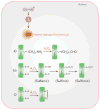Nuclear lipid mediators: Role of nuclear sphingolipids and sphingosine-1-phosphate signaling in epigenetic regulation of inflammation and gene expression
- PMID: 29377310
- PMCID: PMC6023743
- DOI: 10.1002/jcb.26707
Nuclear lipid mediators: Role of nuclear sphingolipids and sphingosine-1-phosphate signaling in epigenetic regulation of inflammation and gene expression
Abstract
Phospholipids, sphingolipids, and cholesterol are integral components of eukaryotic cell organelles, including the nucleus. Recent evidence shows characteristic features of nuclear lipid composition and signaling, which are distinct from that of the cytoplasm and plasma membrane. While the nuclear phosphoinositol lipid signaling in cell cycle regulation and differentiation has been well described, there is a paucity on the role of nuclear sphingolipids and sphingolipid signaling in different physiological and pathophysiological human conditions. In this prospective, we describe the role of sphingolipids and specifically focus on the sphingoid bases, such as sphingosine, ceramide, and sphingosine-1-phosphate (S1P) generation and catabolism in nuclear signaling and function. Particularly, S1P generated in the nucleus by phosphorylation of SPHK2 modulates HDAC activity either by direct binding or through activation of nuclear reactive oxygen species and regulates cell cycle and pro-inflammatory gene expression. Potential implication of association of SPHK2 with the co-repressor complexes and generation of S1P in the nucleus on chromatin remodeling under normal and pathological conditions is discussed. A better understanding of sphingolipid signaling in the nucleus will facilitate the design and development of new and novel therapeutic approaches to modulate expression of pro-inflammatory and cell cycle dependent genes in human pathologies such as cancer, bacterial lung infection, neurodegeneration, and cystic fibrosis.
Keywords: epigenetics; histone acetylation and deacetylation; inflammation; lipids; nuclear signaling; phosphoinositides; sphingolipids; sphingosine kinase 2; sphingosine-1-phosphate.
© 2018 Wiley Periodicals, Inc.
Conflict of interest statement
The authors declare that there is no conflict of interests relating to this manuscript.
Similar articles
-
Epigenetic regulation of pro-inflammatory cytokine secretion by sphingosine 1-phosphate (S1P) in acute lung injury: Role of S1P lyase.Adv Biol Regul. 2017 Jan;63:156-166. doi: 10.1016/j.jbior.2016.09.007. Epub 2016 Sep 29. Adv Biol Regul. 2017. PMID: 27720306 Free PMC article. Review.
-
Regulation of histone acetylation in the nucleus by sphingosine-1-phosphate.Science. 2009 Sep 4;325(5945):1254-7. doi: 10.1126/science.1176709. Science. 2009. PMID: 19729656 Free PMC article.
-
Regulation and function of sphingosine kinase 2 in diseases.Histol Histopathol. 2018 May;33(5):433-445. doi: 10.14670/HH-11-939. Epub 2017 Oct 19. Histol Histopathol. 2018. PMID: 29057430 Review.
-
Sphingolipids Signaling in Lamellipodia Formation and Enhancement of Endothelial Barrier Function.Curr Top Membr. 2018;82:1-31. doi: 10.1016/bs.ctm.2018.08.007. Epub 2018 Sep 27. Curr Top Membr. 2018. PMID: 30360778 Free PMC article.
-
Pseudomonas aeruginosa stimulates nuclear sphingosine-1-phosphate generation and epigenetic regulation of lung inflammatory injury.Thorax. 2019 Jun;74(6):579-591. doi: 10.1136/thoraxjnl-2018-212378. Epub 2019 Feb 5. Thorax. 2019. PMID: 30723184 Free PMC article.
Cited by
-
To Be or Not to Be: The Divergent Action and Metabolism of Sphingosine-1 Phosphate in Pancreatic Beta-Cells in Response to Cytokines and Fatty Acids.Int J Mol Sci. 2022 Jan 31;23(3):1638. doi: 10.3390/ijms23031638. Int J Mol Sci. 2022. PMID: 35163559 Free PMC article. Review.
-
Interface between Resolvins and Efferocytosis in Health and Disease.Cell Biochem Biophys. 2024 Mar;82(1):53-65. doi: 10.1007/s12013-023-01187-4. Epub 2023 Oct 4. Cell Biochem Biophys. 2024. PMID: 37794303 Review.
-
Deregulated expression of the 14q32 miRNA cluster in clear cell renal cancer cells.Front Oncol. 2023 Apr 17;13:1048419. doi: 10.3389/fonc.2023.1048419. eCollection 2023. Front Oncol. 2023. PMID: 37139155 Free PMC article.
-
5-Fluorouracil resistance due to sphingosine kinase 2 overexpression in colorectal cancer is associated with myeloid-derived suppressor cell-mediated immunosuppressive effects.BMC Cancer. 2024 Aug 8;24(1):983. doi: 10.1186/s12885-024-12742-4. BMC Cancer. 2024. PMID: 39118083 Free PMC article.
-
Neuronal and glial DNA methylation and gene expression changes in early epileptogenesis.PLoS One. 2019 Dec 30;14(12):e0226575. doi: 10.1371/journal.pone.0226575. eCollection 2019. PLoS One. 2019. PMID: 31887157 Free PMC article.
References
-
- Albi E, Lazzarini R, Magni MV. Reverse sphingomyelin-synthase in rat liver chromatin. FEBS Lett. 2003a;549:152–156. - PubMed
Publication types
MeSH terms
Substances
Grants and funding
LinkOut - more resources
Full Text Sources
Other Literature Sources






